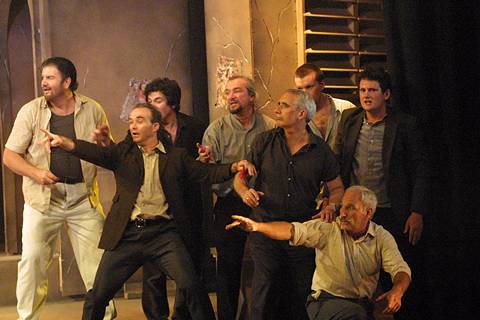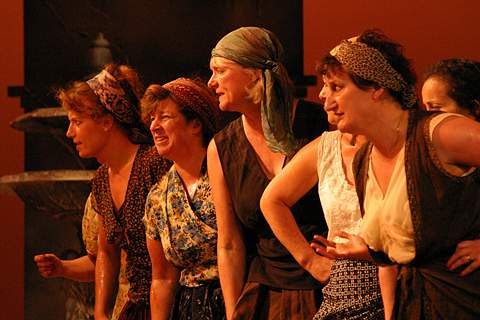|
<< -- 2 -- Roderic Dunnett A SUREFIRE HIT

This was the best sounding chorus Stowe has fielded by a mile. One remembers how audibly and visibly subfusc was the almost apologetic chorus in their otherwise excellent Don Carlo. Fontane is a super-effective director. One only had to watch the chorus moves, its management and manipulation, in Act I, or her shifting blockings also evidenced early in Act IV, to see how clever she is at putting people in the right place. Individual chorus members had small moves, vignettes, flirtations, marital tiffs, modest in themselves, but which added much to the action. No children, alas -- Fontane might have managed those rather well.

Part of Stowe Opera's lively and engaged men's chorus in the 2004 production of 'Carmen'. Photo © 2004 John Credland
|
But the women's choir -- both divisi (following the cigarette factory fracas) and tutti -- was impressive; the soldiery and bar attenders all motivated (at the start of Act II the whole of Lillas Pastia's looks spaced-out with sex and drugs, sleaze and snooze), with first-rate delivery (what a difference impeccable tenors make!); the stylised shuffling robbers' chorus -- looking suspiciously like Welsh National Opera's recent staging -- at least partly effective; the choruses greeting Escamillo genuinely massive in sound. One swishing dance, choreographed by Tanya Cusan, was brilliantly pulled off. Everyone knew exactly where to go, what to do: by no means the norm with such productions, given very limited rehearsal time.

Members of the mutually jibing women's chorus outside the Seville cigarette factory. Photo © 2004 John Credland
|
Two directorial classics were the 'mirroring' of Remendado's Act III on-guard position (rearstage left) by Don José (then placed frontstage left) -- a kind of classic trompe d'oeil, as if we were now viewing the action inverted through 180 degrees -- and Carmen herself steering clear of the action during the Lillas Pastia scene: a series of subtle moves that -- given frenetic activity elsewhere -- almost evaded the eye. Slightly naughty, really : so clever were these moody self-repositionings of Fontane that she silently stole the scene.
But then that's Carmen all over -- just as when Micaëla has finished her big Act III aria, and it's at last explained to the mountain folk -- and to Carmen herself -- that she's José's girl, Fontane throws a telling look to heaven and immediately sets about feigning woman-on-woman jealousy.
Only when we see the glazed, astonished look on her face as she falls like a crumpled doll -- having walked onto the knife almost like an automaton -- do we realise that for once this ultra-bright Carmen's manipulating skills have given out -- or have they? Unforeseen, unguessed; or has she, we almost wonder, elected for her own death?
Continue >>
Copyright © 3 October 2004
Roderic Dunnett, Mirfield, Yorkshire, UK

|

